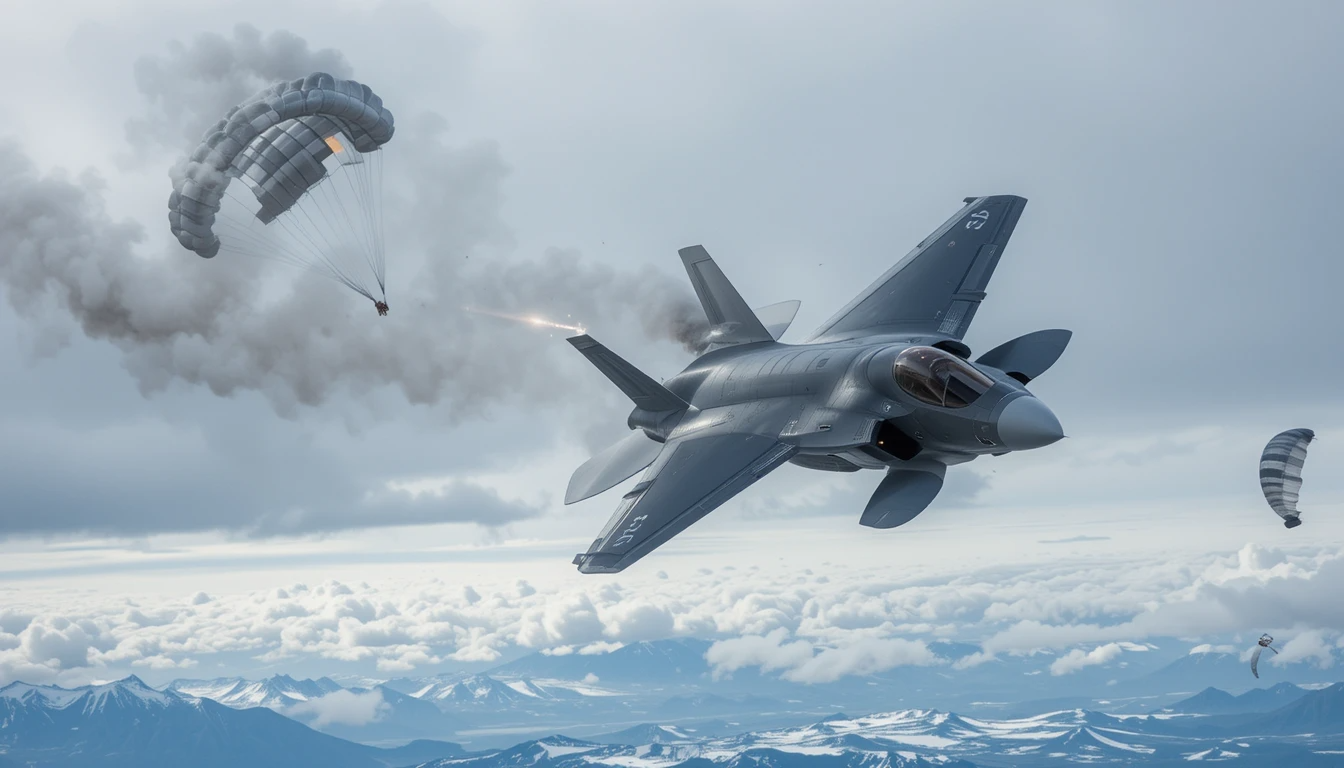On a seemingly routine training mission at Eielson Air Force Base in Alaska, an advanced F-35 fighter jet suddenly spiraled into a catastrophic crash, sending flames and smoke billowing into the sky. The dramatic incident, captured in a heart-stopping video, sent shockwaves through the military aviation community and raised urgent questions about the reliability of one of the world’s most advanced combat aircraft. Fortunately, the pilot ejected in time and was safely transported for medical evaluation. But what exactly went wrong? And what does this mean for the future of the F-35 program? Let’s break it down.
A Routine Flight Turned Dangerous
The F-35 was approaching its landing at Eielson Air Force Base when disaster struck. According to Colonel Paul Townsend, commander of the 354th Fighter Wing, the pilot declared an “inflight emergency” before the crash. Within moments, the aircraft lost control, spun rapidly, and plummeted vertically toward the ground, striking the base’s runway and erupting into flames.
The incident, which occurred at 12:49 p.m. local time, resulted in significant damage to the aircraft. Video footage, reportedly shot from a nearby flight line, shows the jet tumbling uncontrollably with its landing gear extended, then smashing into the runway in a fiery explosion. A parachute is visible in the video—proof that the pilot successfully ejected before impact.
A Narrow Escape for the Pilot
 Despite the catastrophic nature of the crash, the most crucial outcome is that the pilot survived. He was quickly transported to Bassett Army Hospital in stable condition for further evaluation. The U.S. Air Force confirmed that he had sustained no life-threatening injuries.
Despite the catastrophic nature of the crash, the most crucial outcome is that the pilot survived. He was quickly transported to Bassett Army Hospital in stable condition for further evaluation. The U.S. Air Force confirmed that he had sustained no life-threatening injuries.
This is not the first time an F-35 pilot has been forced to eject. The aircraft, known for its cutting-edge stealth and combat capabilities, has also been plagued by multiple high-profile crashes in recent years. While these incidents remain relatively rare, they highlight the risks associated with high-performance military aviation.
Why Did the F-35 Crash?
As of now, the exact cause of the inflight malfunction remains unknown. However, aviation experts suggest that mechanical failure, software glitches, or pilot error could be potential factors. The F-35, a state-of-the-art aircraft built by Lockheed Martin, has long been the subject of scrutiny due to its complexity and technical challenges.
The U.S. Air Force has launched a full investigation into the incident, with hopes of identifying the cause and preventing future occurrences. Colonel Townsend assured the public that safety remains the top priority:
“Our people are our most important resource, and we are committed to ensuring their safety and security.”
A History of F-35 Mishaps
The F-35 is one of the most sophisticated fighter jets in existence, but its history has not been without turbulence. Just last year, another F-35 crashed in New Mexico during a routine flight from Texas to California, severely injuring the pilot. In October, a bizarre incident occurred when a Marine Corps pilot ejected from an F-35 unnecessarily, leaving the aircraft to fly on its own for 11 minutes before crashing into a remote area of South Carolina.
 These incidents have raised concerns about the aircraft’s reliability. Despite its advanced stealth, supersonic speed, and AI-driven systems, the F-35 has faced issues ranging from engine malfunctions to software bugs. Given its crucial role in the U.S. military’s air fleet, addressing these problems is imperative.
These incidents have raised concerns about the aircraft’s reliability. Despite its advanced stealth, supersonic speed, and AI-driven systems, the F-35 has faced issues ranging from engine malfunctions to software bugs. Given its crucial role in the U.S. military’s air fleet, addressing these problems is imperative.
Eielson Air Force Base: A Hub for Advanced Warfare
Eielson Air Force Base, located 25 miles south of Fairbanks, is home to a fleet of over 50 F-35 jets. Since being selected as a key base for these next-generation aircraft in 2016, the installation has seen over half a billion dollars in expansions, including new facilities, housing, and infrastructure to accommodate the growing military presence.
The base plays a critical role in U.S. air defense strategy, particularly in the Arctic region, where global tensions are increasing. With its proximity to Russia and China, Eielson AFB is a strategic asset in maintaining air superiority.
The Future of the F-35 Program
Despite these challenges, the F-35 remains a cornerstone of the U.S. Air Force, Navy, and Marine Corps. Its cutting-edge technology makes it a formidable force on the battlefield, and its stealth capabilities give it a significant advantage over adversaries. However, repeated crashes and technical malfunctions raise an important question: Is the F-35 truly ready to meet the demands of modern warfare?
The U.S. government has invested billions into the F-35 program, and for now, there are no signs of slowing down. However, each incident adds pressure on the Pentagon and Lockheed Martin to refine and enhance the aircraft’s safety and performance.
Final Thoughts: A Wake-Up Call for Military Aviation
 The crash of the F-35 at Eielson Air Force Base serves as a stark reminder of the risks associated with military aviation. While the pilot’s safe ejection is a relief, the incident raises critical concerns about the reliability of one of the most advanced fighter jets ever built. As investigations continue, the U.S. Air Force must prioritize transparency, safety, and improvements to ensure that such mishaps become less frequent.
The crash of the F-35 at Eielson Air Force Base serves as a stark reminder of the risks associated with military aviation. While the pilot’s safe ejection is a relief, the incident raises critical concerns about the reliability of one of the most advanced fighter jets ever built. As investigations continue, the U.S. Air Force must prioritize transparency, safety, and improvements to ensure that such mishaps become less frequent.
What do you think about the F-35 program? Should the military continue investing in it despite its setbacks? Share your thoughts in the comments below!


